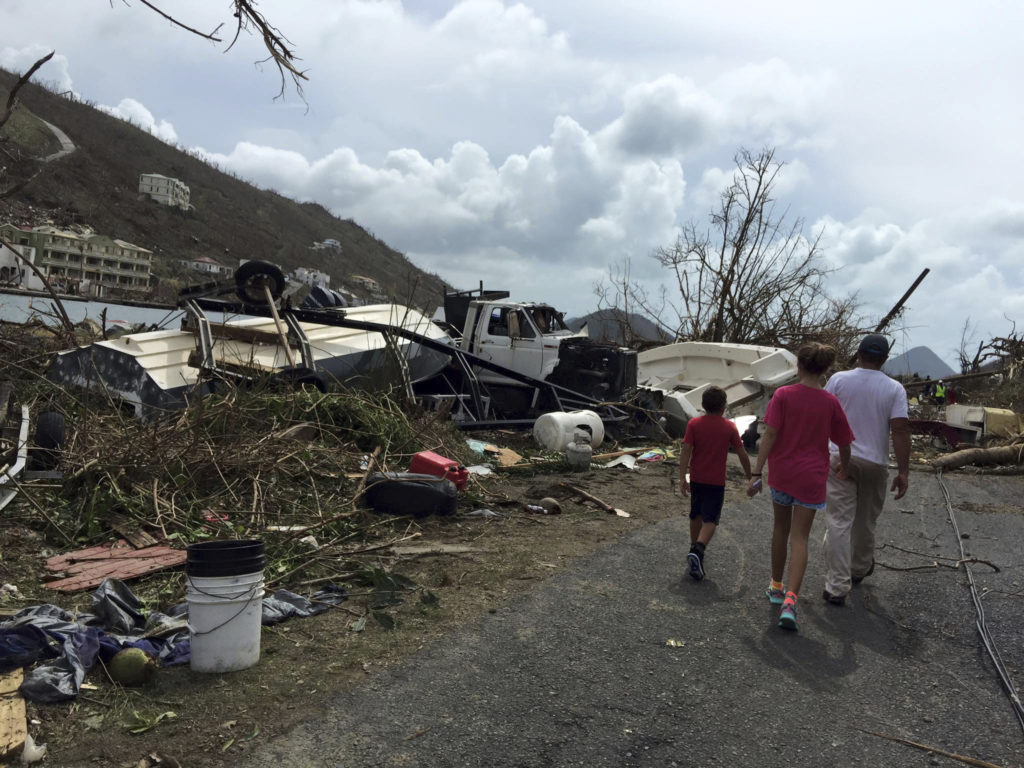136 Pinoys stranded in the Caribbean

In this Sept. 8, 2017 photo, people walk near debris in the aftermath of Hurricane Irma in Tortola, in the British Virgin Islands. Britain has sent a navy ship and troops to help people on the British Virgin Islands, Anguilla and the Turks and Caicos islands that were pummeled by the hurricane. (Gabi Gonzalez via AP)
The Department of Foreign Affairs (DFA) has deployed Manila and US-based diplomats to arrange for the repatriation of 136 Filipinos stranded in the hurricane-devastated British Virgin Islands.
A five-member team from the DFA office of migrant workers affairs led by Undersecretary Sarah Arriola flew to Washington on Monday.
At the same time, four personnel from the Philippine consulates general in New York, San Francisco, Los Angeles and Chicago flew to Puerto Rico to join the team from the Philippine Embassy in Washington.
Together, they will proceed to Tortola, the largest and the most populated of the British Virgin Islands, to bring relief supplies and arrange for a chartered flight to repatriate the Filipinos who have asked to be brought home.
Islands in the Caribbean, including the British Virgin Islands, were hit last week by Category 5 Hurricane “Irma”, one of the most powerful storms to form in the Atlantic Ocean.
“We are exerting our best efforts to reach our kababayans in the British Virgin Islands and bring them all home as soon as possible,” Foreign Secretary Alan Peter Cayetano said in a statement.
Shortage of food
Of the 264 Filipinos in the British Virgin Islands, Cayetano said 136 of them have appealed to be repatriated due to the shortage of food, shelter and basic services.
A total of about 3,000 Filipinos live in the hurricane-devastated islands of Anguilla, Antigua, Bahamas, Barbuda, Saint Barthélemy, Saint Martin, Turks and Caicos, the British Virgin Islands and the US Virgin Islands, according to the DFA.
Worst-hit
Despite the massive damage to the territories, Filipino communities in the worst-hit Anguilla, the British Virgin Islands and Sint Maarten have organized to check on members and coordinate aid efforts with the Philippine embassies in Washington and in The Hague in the Netherlands, the DFA said.
Filipinos in Puerto Rico are also assisting the response team from the Embassy to gather supplies and find ways to transport them to the British Virgin Islands.
Chargé d’Affaires Patrick Chuasoto of the Philippine Embassy in the United States said his office continued to monitor the situation in Florida and neighboring states that were also hit by the hurricane.
Meanwhile, Malacañang on Monday said it was “closely monitoring” the condition of nearly 200,000 Filipinos in the United States who are in areas along the path of Hurricane Irma.
Presidential spokesperson Ernesto Abella assured Filipinos living in Florida, Georgia, and North Carolina that the Philippine Embassy in Washington are on standby for any eventuality.
Monitoring
“We’re closely monitoring the condition of our kababayans that may be affected by Hurricane Irma,” Abella said in a press briefing.
“The Philippine Embassy in Washington, D.C. has already advised the close to 200,000 members of the Filipino community in Florida, Georgia, and South Carolina to comply with evacuation orders issued by authorities,” he said.
Abella said Filipinos in North Carolina and Virginia were also advised to take the necessary precautions after both states were placed under a state of emergency.
“We assure our kababayans that our embassy and consular staff will be on standby in case of any need,” he said.
Hurricane Irma made landfall in Florida on Sunday, pummeling the state with winds up to 130 miles per hour.
The powerful tropical cyclone left 3 million people without electricity while 160,000 people waited in shelters.
US President Donald Trump said the United States may have been “a little bit lucky” after Irma veered from its original projected course on Florida’s eastern coast and instead headed along its west coast.
Some big monster
“We may have been a little lucky in that it went on the west and it may not have been quite as destructive, but we’re going to see,” Trump said.
He described Irma as “some big monster” while meteorologists pointed out that for the first time in 166 years, two Category 4 hurricanes—or those with winds from 130 to 156 mph—made landfall in the United States in the same year.
Category 4 Hurricane Harvey landed in Texas more than two weeks ago and caused extensive flooding.